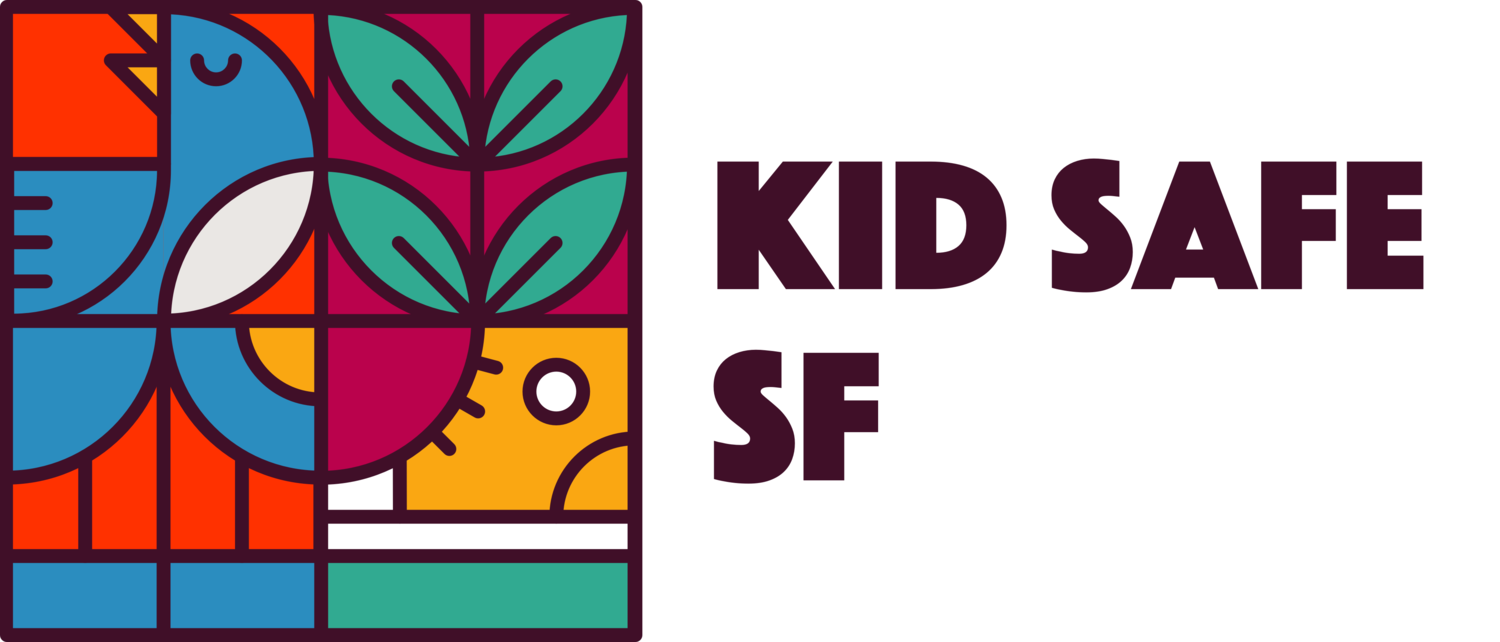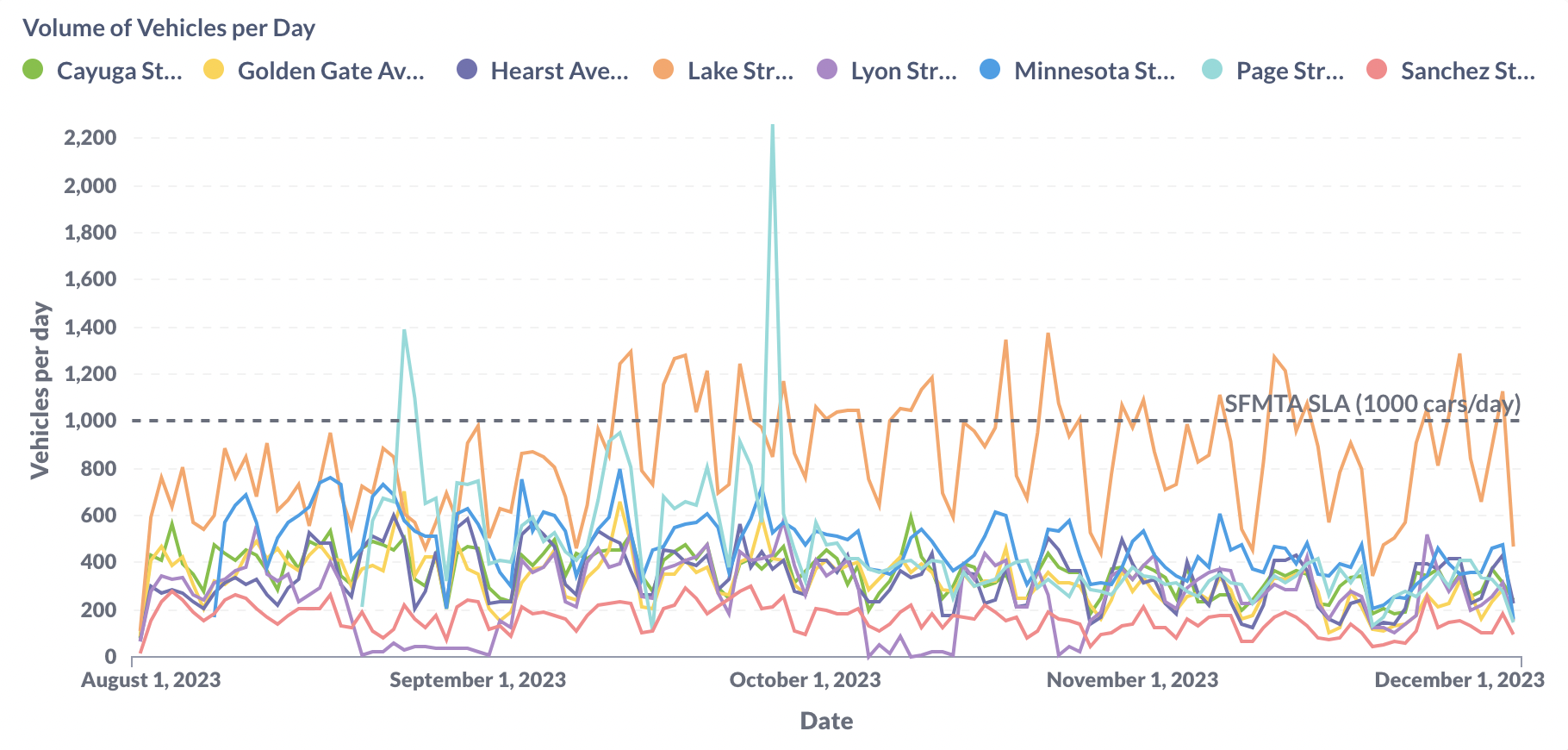One year later: How Slow Are San Francisco’s Slow Streets?
On Dec 6, 2022, the San Francisco Municipal Transportation Agency (SFMTA) established the city’s permanent Slow Streets program, a historic step toward creating a connected network of streets that are safe enough for kids and grandparents to walk and bike around the city. The 18 Slow Streets are expected to meet specific targets tied to safety outcomes: no more than 1,000 vehicles per day, traveling 15mph or less.
At the beginning of 2023, KidSafe SF deployed a network of dozens of Telraam sensors to track how San Francisco’s Slow Streets are performing against these safety goals. Based on data from the sensors, it’s clear that most of the streets are not safe enough to meet the targets adopted by the SFMTA Board in December 2022.
Map of KidSafe SF’s network of Telraam sensors on San Francisco’s Slow Streets
When the Slow Streets Program was made permanent, the SFMTA Board empowered agency staff to calm these streets by implementing elements from the 2023 Slow Streets Design Toolkit – median diverters, speed cushions, roadway narrowing. However, SFMTA has delivered virtually none of the improvements to address the dangerous and persistent speeding conditions on our Slow Streets.
Allowing drivers to persistently abuse the spirit of the Slow Streets designation undermines trust in the program. If the program is to succeed, the agency must invest in improvements to Slow streets to show that they can be truly safe, comfortable streets for all road users.
Key findings from our data
Using our network of Telraam S2 sensors across the city, KidSafe monitored how eight current Slow Streets perform with respect to the vehicle performance goals that the San Francisco Municipal Transportation Agency Board adopted in December 2022.
Most Slow Streets meet the City’s vehicle volume performance goal. Unfortunately there are two exceptions: On most weekdays, Lake Street exceeds the vehicle volume target. Occasionally Page Street has also exceeded 1,000 vehicles per day.
Two Slow Streets are persistently – and dangerously – out of compliance with the speed performance goal: Hearst Avenue and Cayuga Street.
On almost every day since we started aggregating this data, drivers have averaged in excess of 15 mph. About 40% of the time, the observed average vehicle speed exceeds the legal speed limit of 25 mph.
Like Hearst Ave, the observed average speed on Cayuga Street has exceeded the 15 mph average nearly every day.
Most Slow Streets are also out of compliance with the speed performance goal at least some of the time. Of the eight Slow Streets where there are live Telraam S2 Sensors, only Sanchez Street and Golden Gate Avenue consistently report average speeds below the 15 mph target (more on both below).
Recommendations
1. Implement traffic calming measures on Slow Streets that are out of compliance
Median diverters, speed cushions, and roadway narrowing should be installed on streets that are persistently out of compliance with the program.
Every intersection between a Slow Street and an arterial road should have a median diverter or concrete island modal filter to prevent speeding, cut-through traffic, while also allowing residents to reach their homes.
Roadway narrowing, both with mid-block pinchpoints and at intersections with curb bulbouts, is an effective and proven technique to slow speeds.
These treatments are already part of SFMTA’s Slow Streets design toolkit. SFMTA should move quickly to use the existing toolkit to calm traffic on our Slow Streets, and make these streets successful.
2. Continue to evaluate the performance of Slow Streets every 6 months, and when traffic calming measures are implemented
SFMTA evaluated the performance of all Slow Streets in April 2023. There are some key differences between their data and the data from the Telraam network, but the core findings are the same: vehicle volumes are generally in compliance with the program, while speeds are not.
These periodic evaluations should continue as the agency implements more traffic calming measures so that new hot spot streets can be identified.
3. Expand the Slow Streets program to create a connected network for active transportation
As part of the Peoples’ Slow Streets coalition, we advocated for an additional 100 miles of Slow Streets across San Francisco to create a connected network of low-stress routes for active transportation. The agency should ensure that the program is achieving its overall goals for safety through the toolkit of street design treatments as it undertakes a big expansion of the network.
More about the Telraam network
Since the spring of 2023, KidSafe SF and the SF Parks Alliance have worked together to distribute 50 Telraam S2 sensors to residents of San Francisco, with a focus on recruiting hosts on Slow Streets to hold SFMTA accountable to the vehicle volume and speed targets. The Telraam S2 sensor tracks volumes of all road users broken into four categories:
People walking (or pushing strollers and carts)
People on two-wheelers (bicycles, scooters, skateboards, etc.)
Cars
Trucks and other heavy vehicles
The Telraam S2 sensor also tracks the speed of cars (more on that below). All of the traffic data is shared publicly via API and via the Telraam map.
In August 2023, KidSafe SF began aggregating the live data provided by Telraam API to understand trends across different kinds of streets such as arterials, the High Injury Network, and Slow Streets.
We are still expanding the Telraam network to cover even more Slow Streets in San Francisco. If you live on a Slow Street and you would like to host a Telraam S2 Sensor in your window, please complete the very short application (< 60 seconds) and someone from our distribution team will be in touch.
This blog post was authored by Sara Barz, a KidSafe SF and Slow Hearst volunteer who has led our Telraam partnership and network of Slow Streets stewards.



